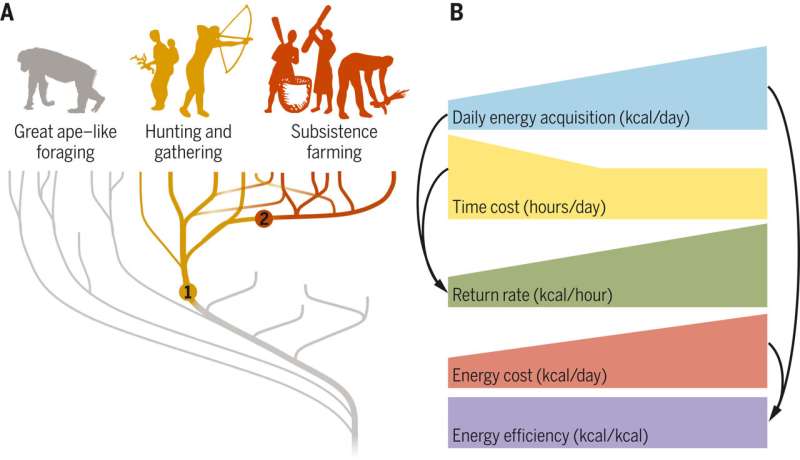December 30, 2021 report
Early humans gained energy budget by increasing rate of energy acquisition, not energy-saving adaptation

A team of researchers affiliated with multiple institutions in the U.S., the Institute for Advanced Study in Toulouse, France and the Max Planck Institute for Evolutionary Anthropology in Germany has found evidence that suggests early humans gained an energy budget by increasing their rate of energy acquisition, not by taking advantage of adaptive strategies. In their paper published in the journal Science, they describe their study of energy expenditure versus energy intake in early humans.
In this new effort, the researchers noted that humans long ago diverged in significant ways from the other great apes. They wondered how this happened and decided to look at energy intake and expenditure. People and other animals have to put in a certain amount of work (expenditure) to receive an energy intake. Climbing a tree to fetch a banana is a simple example. The amount of energy required to climb a tree far outweighs the potential benefit of eating a single banana. But if a single person is able to throw down multiple bananas, then the overall energy intake may surpass the effort of climbing a tree a single time. To learn more about how energy intake and expenditure might have led to modern human characteristics, the researchers studied two groups of modern people—hunter gatherers in Tanzania and forager-horticulturalists in a Bolivian rain forest.
In looking at both groups, they found that both spent more energy on subsistence but also achieved energy efficiencies compared to modern great apes. This was despite the fact that bipedalism and the use of tools are known to decrease the amount of energy expended to obtain food. The result was the acquisition of more food at a much higher rate than the great apes. The researchers suggest this indicates that humans are not cost economizers but are instead creatures that operate in high throughput ways that lead to large payoffs. They suggest that diverging from the great apes in such a way led to the production of so much food that early humans had much more time to do other things, such as socialize. They further suggest that such socializing, combined with the organizational activities involved in obtaining food led to the development of larger brains and from there, other uniquely human attributes.
More information: Thomas S. Kraft et al, The energetics of uniquely human subsistence strategies, Science (2021). DOI: 10.1126/science.abf0130
Journal information: Science
© 2021 Science X Network




















